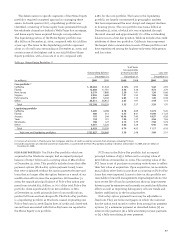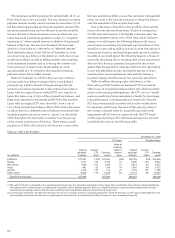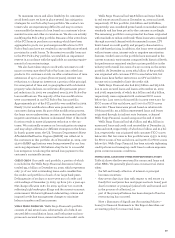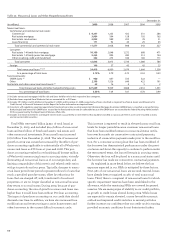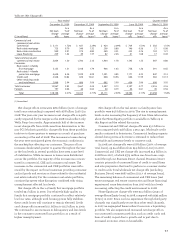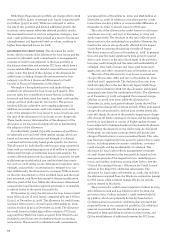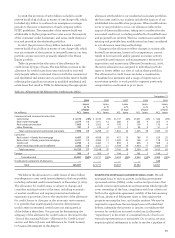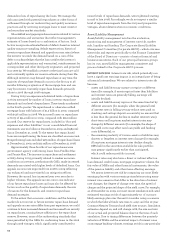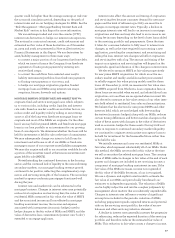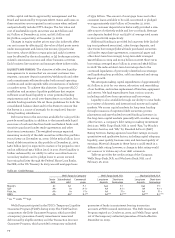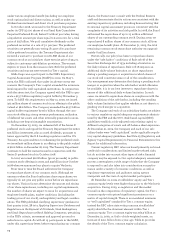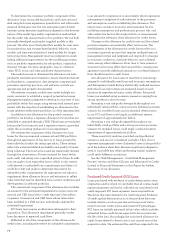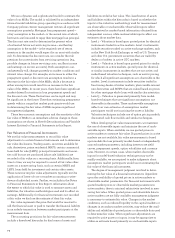Wells Fargo 2009 Annual Report Download - page 68
Download and view the complete annual report
Please find page 68 of the 2009 Wells Fargo annual report below. You can navigate through the pages in the report by either clicking on the pages listed below, or by using the keyword search tool below to find specific information within the annual report.
demands in lieu of repurchasing the loans. We manage the
risk associated with potential repurchases or other forms of
settlement through our underwriting and quality assurance
practices and by servicing mortgage loans to meet investor
and secondary market standards.
We establish mortgage repurchase reserves related to various
representations and warranties that reflect management’s
estimate of losses based on a combination of factors. Such
factors incorporate estimated levels of defects based on internal
quality assurance sampling, default expectations, historical
investor repurchase demand and appeals success rates (where
the investor rescinds the demand based on a cure of the
defect or acknowledges that the loan satisfies the investor’s
applicable representations and warranties), reimbursement by
correspondent and other third party originators, and projected
loss severity. We establish a reserve at the time loans are sold
and continually update our reserve estimate during their life.
Although investors may demand repurchase at any time, the
majority of repurchase demands occurs in the first 24 to 36
months following origination of the mortgage loan and can
vary by investor. Currently, repurchase demands primarily
relate to 2006 through 2008 vintages.
During 2009 we experienced elevated levels of repurchase
activity measured by number of loans, investor repurchase
demands and our level of repurchases. These trends accelerated
in the fourth quarter. We repurchased or otherwise settled
mortgage loans with balances of $1.3 billion in 2009, compared
with $426 million in 2008. We incurred losses on repurchase
activity of $514 million in 2009, compared with $251 million
in 2008. Our reserve for repurchases, included in “Accrued
expenses and other liabilities” in our consolidated financial
statements, was $1.0 billion at December 31, 2009, and $589 mil-
lion at December 31, 2008. To the extent that repurchased
loans are nonperforming, the loans are classified as nonaccrual.
Nonperforming loans included $275 million of repurchased loans
at December 31, 2009, and $193 million at December 31, 2008.
Approximately three-fourths of our repurchases were
government agency conforming loans from Freddie Mac
and Fannie Mae. The increase in repurchase and settlement
activity during 2009 primarily related to weaker economic
conditions as investors, predominantly GSEs, made increased
demands associated with higher levels of defaulted loans. Our
appeals success rate improved from 2008 to 2009 reflecting
our enhanced and more timely loss mitigation efforts.
However, the annual loss increased year over year due to
higher volumes. The appeals success rate is one indicator
of our future repurchase losses and may also be affected by
factors such as the quality of repurchase demands, the mix
of reasons for the demands, and investor repurchase
demand strategies.
To the extent that economic conditions and the housing
market do not recover or future investor repurchase demand
and appeals success rates differ from past experience, we could
continue to have increased demands and increased loss severity
on repurchases, causing future additions to the repurchase
reserve. However, some of the underwriting standards that
were permitted by the GSEs for conforming loans in the 2006
through 2008 vintages, which significantly contributed to
recent levels of repurchase demands, were tightened starting
in mid to late 2008. Accordingly, we do not expect a similar
level of repurchase requests from the 2009 and prospective
vintages, absent deterioration in economic conditions.
Asset/Liability Management
Asset/liability management involves the evaluation,
monitoring and management of interest rate risk, market
risk, liquidity and funding. The Corporate Asset/Liability
Management Committee (Corporate ALCO)—which oversees
these risks and reports periodically to the Finance Committee
of the Board of Directors—consists of senior financial and
business executives. Each of our principal business groups
has its own asset/liability management committee and
process linked to the Corporate ALCO process.
INTEREST RATE RISK Interest rate risk, which potentially can
have a significant earnings impact, is an integral part of being
a financial intermediary. We are subject to interest rate risk
because:
• assets and liabilities may mature or reprice at different
times (for example, if assets reprice faster than liabilities
and interest rates are generally falling, earnings will
initially decline);
• assets and liabilities may reprice at the same time but by
different amounts (for example, when the general level
of interest rates is falling, we may reduce rates paid on
checking and savings deposit accounts by an amount that
is less than the general decline in market interest rates);
• short-term and long-term market interest rates may
change by different amounts (for example, the shape of
the yield curve may affect new loan yields and funding
costs differently); or
• the remaining maturity of various assets or liabilities may
shorten or lengthen as interest rates change (for example,
if long-term mortgage interest rates decline sharply,
MBS held in the securities available-for-sale portfolio
may prepay significantly earlier than anticipated,
which could reduce portfolio income).
Interest rates may also have a direct or indirect effect on
loan demand, credit losses, mortgage origination volume, the
fair value of MSRs and other financial instruments, the value
of the pension liability and other items affecting earnings.
We assess interest rate risk by comparing our most likely
earnings plan with various earnings simulations using many
interest rate scenarios that differ in the direction of interest
rate changes, the degree of change over time, the speed of
change and the projected shape of the yield curve. For example,
as of December 31, 2009, our most recent simulation indicated
estimated earnings at risk of approximately 5% of our most
likely earnings plan over the next 12 months using a scenario
in which the federal funds rate rises to 4.25% and the 10-year
Constant Maturity Treasury bond yield rises to 5.50%. Simulation
estimates depend on, and will change with, the size and mix
of our actual and projected balance sheet at the time of each
simulation. Due to timing differences between the quarterly
valuation of MSRs and the eventual impact of interest rates
on mortgage banking volumes, earnings at risk in any particular



